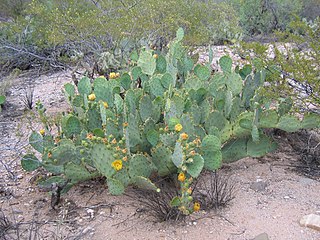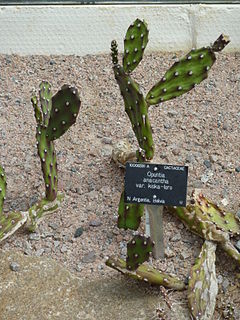
A cactus is a member of the plant family Cactaceae, a family comprising about 127 genera with some 1750 known species of the order Caryophyllales. The word "cactus" derives, through Latin, from the Ancient Greek κάκτος, kaktos, a name originally used by Theophrastus for a spiny plant whose identity is now not certain. Cacti occur in a wide range of shapes and sizes. Most cacti live in habitats subject to at least some drought. Many live in extremely dry environments, even being found in the Atacama Desert, one of the driest places on earth. Cacti show many adaptations to conserve water. Almost all cacti are succulents, meaning they have thickened, fleshy parts adapted to store water. Unlike many other succulents, the stem is the only part of most cacti where this vital process takes place. Most species of cacti have lost true leaves, retaining only spines, which are highly modified leaves. As well as defending against herbivores, spines help prevent water loss by reducing air flow close to the cactus and providing some shade. In the absence of leaves, enlarged stems carry out photosynthesis. Cacti are native to the Americas, ranging from Patagonia in the south to parts of western Canada in the north—except for Rhipsalis baccifera, which also grows in Africa and Sri Lanka.

Nopal is a common name in Spanish for Opuntia cacti, as well as for its pads.

Opuntia ficus-indica, the prickly pear, is a species of cactus that has long been a domesticated crop plant grown in agricultural economies throughout arid and semiarid parts of the world. Likely having originated in Mexico, O. ficus-indica is the most widespread and most commercially important cactus.
Hylocereus is a former genus of epiphytic cacti, often referred to as night-blooming cactus. Several species previously placed in the genus have large edible fruits, which are known as pitayas, pitahayas or dragonfruits. In 2017, a molecular phylogenetic study in 2017 confirmed an earlier finding that the genus Hylocereus was nested within Selenicereus, so all the species of Hylocereus were transferred to Selenicereus.

Cylindropuntia is a genus of cacti, containing species commonly known as chollas, native to northern Mexico and the Southwestern United States. They are known for their barbed spines that tenaciously attach to skin, fur, and clothing. Stands of cholla are called cholla gardens. Individuals within these colonies often exhibit the same DNA, as they were formerly tubercles of an original plant.

The Cactoideae are the largest subfamily of the cactus family, Cactaceae. Around 80% of cactus species belong to this subfamily. As of August 2018, the internal classification of the family Cactaceae remained uncertain and subject to change. A classification incorporating many of the insights from the molecular studies was produced by Nyffeler and Eggli in 2010.

Opuntioideae is a subfamily of the cactus family, Cactaceae. It contains 15 genera divided into five tribes. The subfamily encompasses roughly 220-250 species, and is geographically distributed throughout the New World from Canada, to Argentina. Members of this subfamily have diverse habits, including small geophytes, hemispherical cushions, shrubs, trees, and columnar cacti consisting of indeterminate branches or determinate terete or spherical segments.

Opuntia stricta is a large sized species of cactus that is endemic to the subtropical and tropical coastal areas of the Americas and the Caribbean. Common names include erect prickly pear and nopal estricto (Spanish). The first description as Cactus strictus was published in 1803 by Adrian Hardy Haworth. In 1812 he introduced the species in the genus Opuntia.

Opuntia phaeacantha is a species of prickly pear cactus known by the common names tulip prickly pear and desert prickly pear found across the southwestern United States, lower Great Plains, and northern Mexico. The plant forms dense but localized thickets. Several varieties of this particular species occur, and it also hybridizes easily with other prickly pears, making identification sometimes tricky.

Opuntia humifusa, commonly known as the devil's-tongue, Eastern prickly pear or Indian fig, is a cactus of the genus Opuntia present in parts of eastern North America.

Opuntia, commonly called prickly pear, is a genus of flowering plants in the cactus family Cactaceae. Prickly pears are also known as tuna (fruit), sabra, nopal from the Nahuatl word nōpalli for the pads, or nostle, from the Nahuatl word nōchtli for the fruit; or paddle cactus. The genus is named for the Ancient Greek city of Opus, where, according to Theophrastus, an edible plant grew and could be propagated by rooting its leaves. The most common culinary species is the Indian fig opuntia.

The Conscience Point National Wildlife Refuge was established July 20, 1971 as a land gift from Stanley Howard. The 60-acre (24 ha) refuge is located in the hamlet of North Sea on the north shore of Long Island's south fork. The refuge protects grasslands, oak-beech forest, shrub habitats, kettle holes, freshwater marsh and salt marsh.

Opuntia chlorotica is a species of plant in the family Cactaceae. It is a species of prickly pear native to the southwestern United States and northern Mexico. Its common names include pancake prickly pear, flapjack prickly pear and dollarjoint prickly pear.

Prickly pears include a number of plant species that were introduced and have become invasive in Australia.

Dactylopius is a genus of insect in the superfamily Coccoidea, the scale insects. It is the only genus in the family Dactylopiidae. These insects are known commonly as cochineals, a name that also specifically refers to the best-known species, the cochineal. The cochineal is an insect of economic and historical importance as a main source of the red dye carmine. It has reportedly been used for this purpose in the Americas since the 10th century. Genus Dactylopius is also important because several species have been used as agents of biological pest control, and because several are known as invasive species.
Luigi Carlo Giuseppe Bertero was an Italian physicist, physician, naturalist, botanist, bryologist and pteridologist. He explored the West Indies between 1816 and 1821 coinciding with the Venezuelan scientist and later president, José María Vargas in Puerto Rico although there is no evidence of any exchange between them. During his two voyages, February 1828 to September 1830 and between March and May 1830, he collected and described the flora of Chile. He also examined plants native to the Pacific island of Juan Fernandez, as well as Guadeloupe, Haiti, Puerto Rico, and Colombia. He is presumed lost in a shipwreck while sailing from Tahiti to Chile.

Opuntia lindheimeri is a species of cactus native to North America. It is native to Mexico and the United States, where its populations are primarily in Texas.
Opuntia ammophila, the devil's-tongue, is a species of prickly pear cactus in Florida. Individuals typically occur singly and do not generally form dense thickets. O. ammophila was once considered a variety of O. humifusa; however, it is a distinct species. Among their many differences, O. ammophila has gray-green cladodes rather than green or grass-green.

Opuntia cespitosa, commonly called the eastern prickly pear, is a species of cactus native to North America. It most common west of the Appalachian Mountains and east of the Mississippi River, where it is found in the Midwest, Upper South and in Ontario. Its natural habitat is in dry, open areas, such as outcrops, glades, and barrens.

Opuntia anacantha is a species belonging to the family Cactaceae, native to northern Argentina and Bolivia.

















